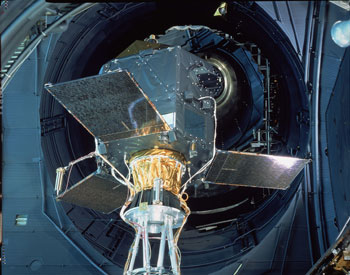
Hipparcos undergoing testing. (Image courtesy of ESA 2002.)
The first ever astrometric satellite, and predecessor of the Gaia mission, was the European Space Agency's Hipparcos mission, loosely named after the Greek astronomer Hipparchus. It was launched on 8 August 1989, and operated from November 1989 till April 1993. The mission used an input catalogue of 120 000 sources to be observed. The data were processed by two data reduction consortia, Fundamental Astronomy by Space Techniques (FAST), based in France, Italy, Germany and the Netherlands, and Northern Data Analysis Consortium (NDAC) based in Sweden, Denmark, and the United Kingdom. The two consortia both had the task of reducing the full data stream, and the combined results of these reductions were made public in 1997. The Hipparcos catalogue is now the optical realisation of the International Celestial Reference Frame, and as such provides the positional reference for all optical observations. The Hipparcos data were re-processed after the discovery of anomalies in the satellite attitude.
The continuous data stream from the Hipparcos star mappers was used to create the Tycho catalogue, which provides position, proper motion and colour information for around 2 million stars. The proper motions were obtained through comparison with early 20th century photographic surveys, the Astrographic Catalogue and the Carte du Ciel.
Read more about Hipparcos on ESA's websites
Page last updated: 05 July 2021
